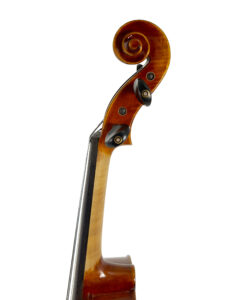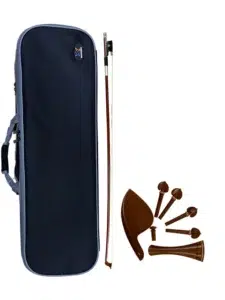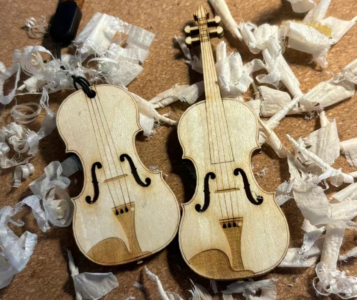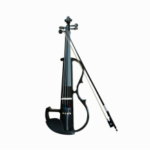There are very many implications of buying a cheap violin for beginners. At this point, most people will just go ahead and buy a violin that they think is cheap. However, you may think that a cheap violin can also be an excellent way to start learning, so you may choose a cheap or a colored violin. However, an unprofessional teacher can’t give more valuable guidance to the student, and a cheap violin with poor material can’t make the beginner learn better.
What is a cheap violin like?
A cheap violin does not allow beginners to improve and learn better. Although cheap violins are prepared for beginners, beginners can’t progress with them, so we should avoid buying them.
Cheap violins will not be made of European maple or the popular moldings; they may be made of synthetic boards. Expensive violins will be made of tonewoods, and these will not be sold with a specific indication of where the wood comes from because there is nothing to say. These woods have no grain, or the grain is hard to see.
The contour of the violin may not be up to standard, and it is not made according to traditional Italian violin craftsmanship. Painted or sprayed with industrial varnish, possibly harmful industrial varnish. The headstock will be poor and use low quality fittings in order to minimize the production time, will you like this kind of violin?
When you start to go to use this violin, you can judge the quality of this violin based on the level and sound. There is no way you can make beautiful music from a violin that is made of poor materials, especially if you are a novice and don’t have a lot of skills to get the best out of the violin. We now know that many violinists can play a normal violin like a professional violin, and with their many years of practice, how can we compare, only from a good violin itself, to produce a normal level?
Reasons that prevent you from learning
As mentioned above, buying a cheap violin can cause learning difficulties because of its problems. For example, a violin with a curved bridge that is not set up will make you practice in a way that will make the bow touch other strings easily. It makes it impossible to play properly.
When we learn the violin, more time should be spent practicing it rather than because of it, to prevent defects and develop wrong, redundant practice habits.
Incorrect nut height
A violin with an incorrect nut height has a high nut, which causes the left hand to need more force when pressing down. If the nut is low, the strings will easily wear out the fingerboard, and the strings will fit tightly against it.
Bridge feet do not fit.
If the bridge is not fitted to the top plate, it will be easy to fall on the violin’s top plate when practicing, leading to unexpected accidents. Because the top plate is not fitted, it will lead to uneven body resonance, and the sound will not be transmitted well. Therefore, both bridges must fit on the top plate of the violin.
Incorrect bridge height.
If the bridge height is too high, the tonal colors will be dull and low, while there will be a lot of sharp noise if it is too low. If the bridge is 2 millimeters higher, the pressure on the bridge increases. The general bridge height is about 33-36mm.
pegs going out of tune easily.
When there is a problem with the friction between the pegs and the axle, going out of tune may occur. Under reasonable conditions, pegs will not come out of the saddle.
Unpleasant string tonal colors
The most common types of strings are steel wire strings (also referred to as metal strings) and nylon strings. When we feel that the tonal colors of the strings are unpleasant, we need to analyze the cause.
Wire strings are strings with a core of steel wire inside, and G, D, and A strings with an outer layer of silver, aluminum, or alloy wrapping. The general violin is equipped with this kind of string, characterized by high-tension explosive sound; the string can withstand the bow’s greater pressure to make a sudden, gradual reduction in strength, as well as the amplitude of the tonal colors of the changes, in addition to the pronunciation of the sensitive, pure and resonant sound concentration. The disadvantages of silver metal strings are, firstly, the metallic sound. Secondly, they are too hard and thin, especially the A string.
The biggest advantage of nylon strings is that they combine the strengths of Gut core strings and steel wire strings, both close to the Gut core strings of the beautiful tonal colors, but also the volume and stability of the steel wire strings, soft, sweet pronunciation, volume than the metal strings to be slightly smaller. Although its core strings are also affected by humidity and temperature, just as gut core strings are, the amplitude of the change is much smaller than that of gut core strings. Some use nylon strings for G, D, and A. Some only use nylon strings for G and D and no nylon for E-Strings.
A suitable set of strings can cover up the instrument’s shortcomings. The better violins usually come with nylon nylon strings. Steel wire strings can only be used as a violin to open up the sound initially; the metal sound is too strong, and some lyrical tunes will be very hard, making people uncomfortable.
Tuning Difficulty
The violin needs tuning before every practice. It’s been a while since the last practice, and the air’s humidity, the weather’s temperature, and the after-practice can all lead to the violin strings sounding out of standard. If you can’t hear it by ear, you need a tuner to help us adjust the standard tone.
Cheap violin, because of poorly crafted, adjusting the tone is easy, not long after tuning, going out of tune, and need to spend time to adjust again.
Plywood Violins
Plywood violins are made differently than all-solid wood violins by making multiple thin boards of wood through a gluing technique. Full solid wood violins are made from a single piece of solid wood and have superior tonal qualities but are relatively more expensive. Plywood violins are more economical and practical than all solid wood violins and are suitable for beginners or musicians on a limited budget, but that’s a no-brainer because the difference is still pretty big.
Plywood violins usually use woods such as poplar and maple for the body, and the neck is usually made of hardwoods such as beech or maple. It is difficult to pay attention to factors such as color, texture, and density when choosing materials. The final violin made has average tonal qualities and is not suitable for long-term use.
ordinary bow tension
The bow looks like a violin accessory, but its production is also a great test of the bow maker’s craftsmanship. The bow must be twisted so that the bow hairs do not touch the bow, especially when practicing, which means it is still not tight enough. After practicing for a while, the elasticity of the bow hair decreases and needs to be replaced, depending on the frequency of practicing the violin.
Ordinary bow tension, pulled shortly after the loss of elasticity, needs to be replaced often; the violin bow’s general distribution is average, and the need for a better bow the price can go the purchase of the violin price of one-third, or perhaps more.
Benefits of choosing a more expensive violin
The point I want to make here is that the more expensive violins use better materials. Generally, we believe that a violin should be made of good wood, and this wood includes a spruce top plate, maple back plate, and violin sides.
Easier to play
A better violin will help you play smoother. A well-made violin should be tuned by a luthier. The fitting of the violin bridge and sound post all affect the tonal colors of the violin.
the ear knows more about the note and that it is in tune.
When I tried the better violin, I felt that that peg was easier to tune accurately. The violin is easier to tune, and the ear will feel the tonal colors more pleasant to the ear.
Better tonal qualities
The year in which the wood of a violin is air-dried affects the moisture content of the wood. The longer the years of air-drying, the lower the moisture content will be until it reaches an equilibrium point so that the violin resonates well when played, and the tonal qualities will be more layered.
Boost Your Self-Confidence
When you can play a tune that is not too difficult to hear every time, then you can be sure that you will get better the more you practice. It increases the practitioner’s confidence, but of course, it takes a long time to train.
Made of solid wood and away from industrial waste.
A solid wood violin structure, held in place by the purfling, is stable and can be repaired; if it is one of those cheap violins with painted-on purfling that is cheaply glued in place, there is no need for repair. Suppose it is in accordance with the factory violin. In that case, there will be a large share of the smell of chemicals, and the configuration of many accessories are plastic, poor quality, and not long to use.
Solid wood violins with carefully carved maple scrolls present a naturally smooth surface that showcases its sturdy edges and corners. The ebony fingerboard is thick and textured, providing comfort and responsiveness when pressed. The custom ebony chin rest is ergonomically designed to provide stability and comfort during extended playing sessions. Precisely measured string heights ensure ease and comfort. Being able to touch the fittings of the violin affects the feeling of use.
carefully setup
After production and before it reaches the consumer, the luthier needs to fit the violin to its optimum condition. This way, once it arrives, you can start practicing the violin and feel the marvelous music it can play.
How to avoid cheap violins?
We need to pick at a reasonable price point for a normal violin, and if it is too cheap, we can know what material it is made of; after all, the cost is there. Consult the studio or seller to what material the composition of the violin, and judge it.
Then we need to look at some selection tips articles to help us identify how to be a good violinist; we also need to feel the sound from the violin is not what we want.
Violins are generally made to be user-friendly. They are supplied with a sturdy rectangular case that includes basic accessories such as rosin, strings, shoulder rests, electronic tuners, and polishing cloths to provide convenience and protection for your instrument.






